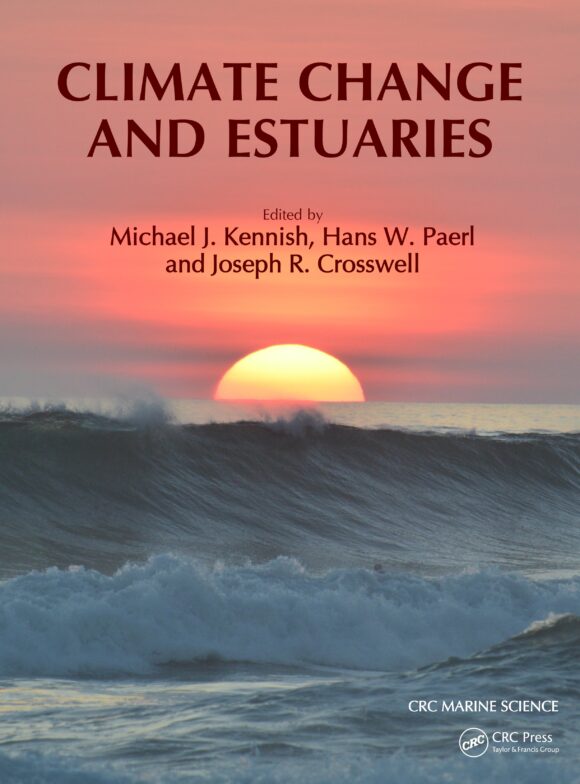The seminal international publication coincides with National Estuaries Week.
National Estuaries Week, which will be observed this year from Sept. 16-23, is an annual celebration of the environmental significance of estuaries. Established in 1988 as National Estuaries Day, it was expanded to a weeklong observation to increase public awareness of the critical ecological and societal importance of estuaries.
The new publication, Climate Change and Estuaries, showcases the value of estuaries and the threats posed by climate change. It will be published on Sept. 15 to usher in National Estuaries Week.
 The comprehensive volume, consisting of 32 chapters and nearly 700 pages, highlights climate change effects on estuarine ecosystems from local, regional, and global perspectives and is the brainchild of Michael Kennish, Professor Emeritus in the Department of Marine and Coastal Sciences. Kennish is also the lead editor and author of three chapters.
The comprehensive volume, consisting of 32 chapters and nearly 700 pages, highlights climate change effects on estuarine ecosystems from local, regional, and global perspectives and is the brainchild of Michael Kennish, Professor Emeritus in the Department of Marine and Coastal Sciences. Kennish is also the lead editor and author of three chapters.
According to Kennish, Climate Change and Estuaries has been four years in the making and draws on the expertise of 75 authors from 10 countries, with strong contributions from four other Rutgers scientists.
Joanna Burger, Distinguished Professor in the Department of Ecology, Evolution, and Natural Resources, authors the chapter on climate change and birds. L. Fernando Pareja-Roman, research associate in the Department of Marine and Coastal Sciences, is the lead author of the chapter on climate change and estuarine circulation. Robert J. Chant, professor in the Department of Marine and Coastal Sciences, co-authors the chapter on climate change and estuarine circulation, and Kenneth Able, Distinguished Professor Emeritus in the Department of Marine and Coastal Sciences, co-authors the chapter on climate change and fish.
Estuaries rank among the most productive ecosystems on Earth, rivaling those of coral reefs and tropical rain forests. They are complex and dynamic transitional environments where the land meets the sea and freshwater runoff mixes with seawater, resulting in salinity gradients, a continuum of biogeochemical cycles and biota from freshwater to marine, as well as an array of distinctive habitats.
“They are vital environments, teeming with life from microbes to mammals. Numerous marine species of recreational and commercial importance inhabit estuaries during their lifetime and support valuable fisheries,” explains Kennish.
With approximately 40% of the world’s eight billion human population living within 100 km of the coast, many depend on the provision of estuarine environments that yield valuable goods and services to society.
“The global value of estuarine ecosystem services and that of adjoining coastal wetlands is estimated to be in the trillions of dollars and includes broad and essential ecological, economic, and societal benefits,” he adds.
Because of the high human population and development in coastal watersheds, estuaries are increasingly susceptible to the worsening effects of climate change.
“There is a great need to assess the effects of climate change in estuaries and to implement the measures necessary to remediate the adverse impacts. Climate Change and Estuaries deals with all of these matters,” says Kennish.
Kennish, a Rutgers alumnus, is the author or editor of 16 scholarly books. He has been recognized for his outstanding contributions to the field, in particular his seminal research of anthropogenic effects on estuarine, coastal, and marine environments. He’s also authored more than 200 peer-reviewed journal articles and book chapters, and has served as the editor of nine peer-reviewed compendium science journal special issues. Two of his most impactful books published over the past several years include the Encyclopedia of Estuaries and the fourth edition of the Practical Handbook of Marine Science.
Climate Change and Estuaries is considered essential reading for climate scientists, marine and estuarine scientists, environmental scientists, professors and students, coastal and resource managers, program administrators, policy makers and other professionals engaged in some aspect of work on coastal, estuarine and marine environments.
Original article at Rutgers Newsroom

